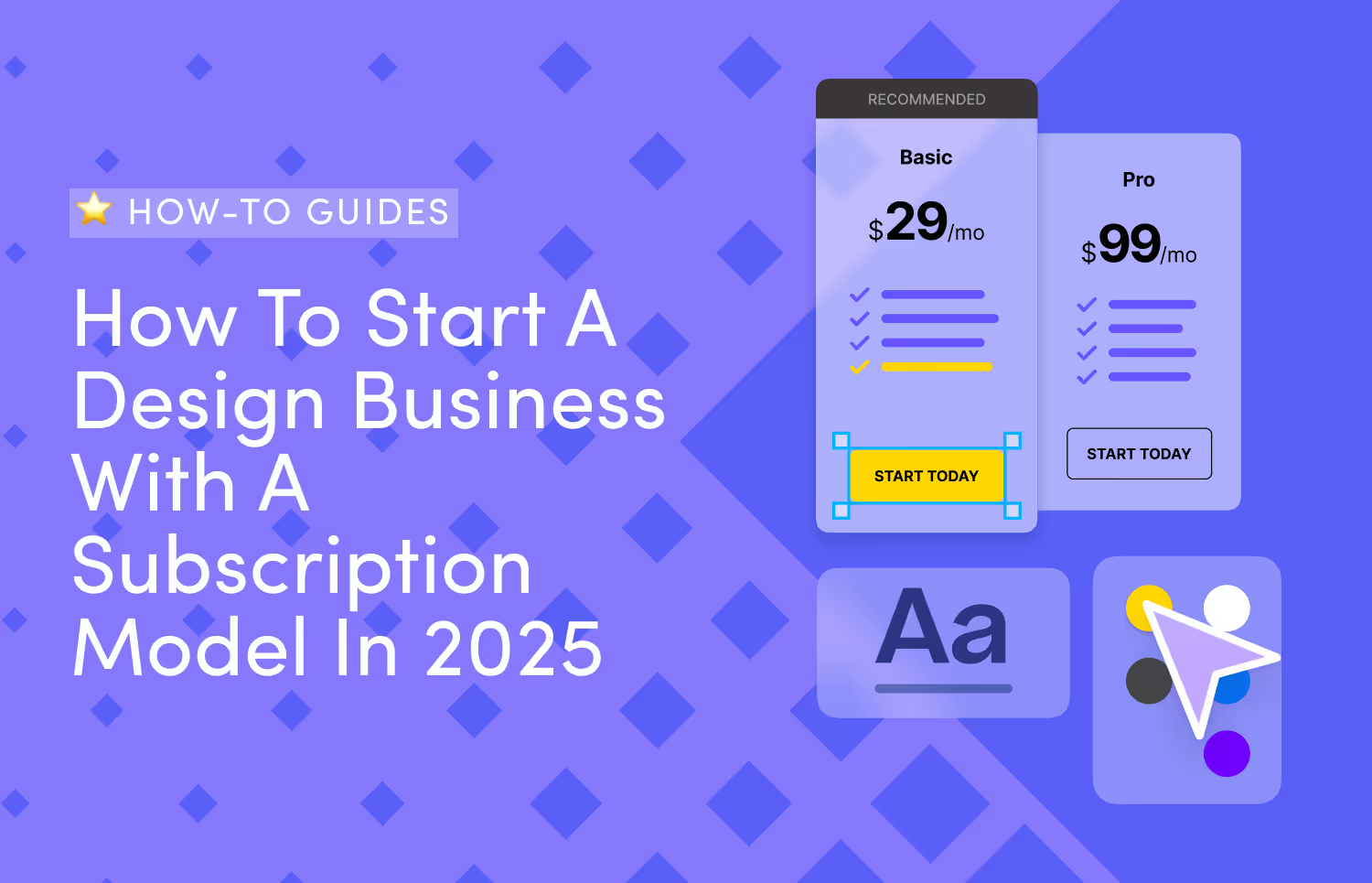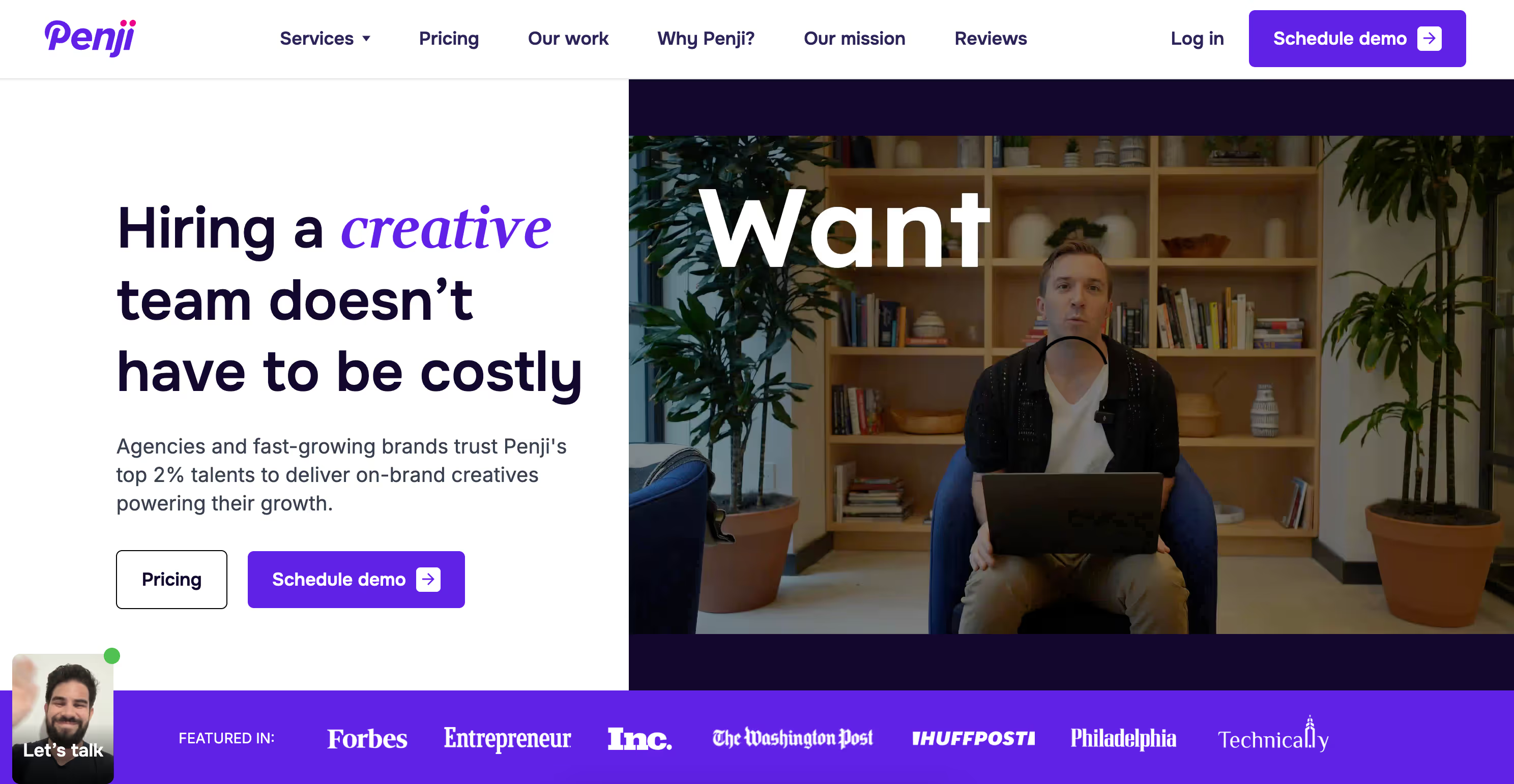How to Start a Design Business with a Subscription Model in 2025
Learn how to start a design business with a subscription model for stable, recurring revenue, and long-term client growth.




Quick question for you: Do you wish to scale? There’s a quick answer to that: Shift away from one-time design projects.
Why? Under this traditional approach, every project is a new negotiation, and every client has a different workflow that fluctuates revenue from month to month—it’s hard to build momentum.
The subscription-based design model is the best option. It offers predictable revenue, eliminates the need for constant pricing discussions, and promotes operational efficiency. But perhaps your mind is already working overtime, thinking about how to start a design business. That’s what this guide is for—we’ll walk you through everything you need to know.
We'll explain why starting a subscription-based service suits graphic design agencies and why this business model (among others) is the logical next step if you’re already growing.
If you look closely, every business today needs a constant stream of visual content. In 2022, nearly 47% of marketing professionals reported outsourcing graphic design needs.
Those that once needed a logo and a few website assets now require a continuous flow of design materials to stay competitive. Social media platforms (Instagram, Facebook, TikTok, etc.) are highly visual, SEO now includes visual content as a ranking factor, and the need for effective brand communication has made visual content an essential component of business success.
Here’s a reasonable conclusion:
So, why is being subscription-based the next logical step for you? All because it addresses the instabilities and limitations that have constrained growth. For design agencies ready to evolve beyond the project-to-project hustle, the subscription model offers the following benefits:
The project-based model generates unpredictable cash flow—some months are packed with projects, while others are slow. A subscription model replaces this with recurring revenue, so you know exactly how much money is coming next month. And the month after that. Therefore, you can:
A subscription model eliminates the inefficiency of negotiating pricing, creating proposals, and revising contracts for each client. The sales conversation transforms from "What's your budget?" to simply saying: "Here are our three packages. Which one fits your needs best?"
This productized service approach to design services means your offerings become standardized, repeatable, and systematized. Rather than reinventing the wheel with every new client, you've created a clear product that clients can easily understand and purchase. Your sales cycle shortens—they either want what you offer at the price you've set, or they don't.
Scope creep is a common problem in project-based work. Ever had a client who keeps adding "just one more small thing" until your project spirals out of control? With subscription packages, boundaries are crystal clear. If a client needs more design requests, there's a clear pathway to upgrade.
A one-time project doesn’t always turn into repeat business. Subscription models change your client relationships for the better. Instead of the transactional approach, you become an extension of their team. You learn their brand inside and out. The result? Clients stick around for years, not months.
Like any business model, the subscription approach isn't flawless. So, before you dive in, know what you're signing up for—both the benefits and the flip side.
Key points to consider
This is a real thing. People are running successful businesses using this model for design. Here are some examples of subscription-based graphic design businesses:
Unlimited design services let clients submit as many design requests as needed for a fixed monthly fee. While "unlimited" doesn't mean simultaneous processing of all requests, clients can queue up multiple tasks without incurring additional costs per project.
Examples:

Penji: With Penji, clients can request as many designs as they need—no hourly rates, no per-project fees. Designs are completed one at a time, and as soon as one is finished, the next request in the queue starts.

Design Pickle: Every plan has unlimited design requests and revisions, so clients can keep sending in projects without worrying about extra fees.
Some subscription-based services cater to specific industries like SaaS, eCommerce, or real estate. This specialization allows them to understand the unique design needs of these sectors and provide tailored solutions.
Example:
A service focused on creating engaging social media graphics specifically for fitness coaches, helping them maintain a consistent brand image across their online platforms.
You don't have to be a big company to do this. So, how to start a design business by yourself, you ask? You can start small, as a solo designer. You might offer a subscription to a limited number of clients per month. This lets you provide really focused attention and build strong relationships. You could only take on 3-5 clients at a higher price point.
But the beauty of this model is that it's scalable. Once you get the hang of it and the demand is there, you can start scaling with a team (creative agency) to handle a higher volume of requests.
Want to offer more value to clients and command higher subscription prices? Opt for hybrid models that integrate graphic design with other strategic services like branding, web design, or marketing strategy.
For example, you might offer a subscription package with logo design and brand guidelines as an initial setup.
At this point, we’re talking about how you set up your business from day one. A strong foundation means choosing the right niche, structuring profitable pricing, and building a seamless client experience.
You've got two main options: be a generalist or specialize in a specific area.
If you're unsure which to pick, here’s a suggestion: start as a generalist with structured tiers and analyze which requests dominate. Then, double down on that niche.
Why? Because when you specialize, you can charge more. You're not competing on price anymore but on expertise. Being a generalist design agency is the fastest way to commoditize yourself, interchangeably with every other design agency. So, try to make clear choices:
Flat-rate pricing or tiered plans? Your pricing strategy dictates your profit margins, scalability, and retention. Flat-rate pricing works well if you have a hyper-specific offering. But for most, tiered pricing creates natural upsell opportunities.
Pricing strategy pro tip:
Your workflow is also your sales differentiator. You’re selling a reliable system for getting design work done. The process itself becomes what clients are paying for. And to keep your workflow smooth, you need the right tools. Platforms like ManyRequests can help organize tasks, set deadlines, and keep clients informed about the status of their projects.
Also, defining clear boundaries is the key to profitable subscription design. Created detailed service-level agreements that leave zero room for misinterpretation. So, be explicit about:
Moving on to client acquisition, this is mainly about finding the right people who need your help and showing them why you're the best option.
Your model changed. Your best clients now aren't the same as those for one-off project work. You need clients with consistent, ongoing design needs. Get specific—are we talking about startups that need to get their brand off the ground?
Maybe eCommerce brands that constantly need fresh graphics for their product listings and ads? Or what about marketing agencies that are swamped with design work and need a reliable partner? Identify them and work on how to find them.
Once you know who you’re targeting, the next step is to ensure they find you.
Subscription-based services win when they rank for the right keywords and become a trusted resource. Content marketing is your secret weapon. Don't forget about paid advertising and social media strategies. You might have to spend a little money to make money here, but it can be worth it. And don't underestimate the power of building a referral or affiliate program. Happy clients are your best salespeople!
Once you've attracted potential clients, it's crucial to have a smooth sales and onboarding process.
Make it easy for people to sign up and get started. Use clear and simple contracts that spell out precisely what they're getting and what's expected. And this is super important: set clear expectations for deliverables right from the get-go. Remind them about your turnaround times, including your revision policies.
ManyRequests shines in this area as a client onboarding software that provides the following:
Here’s how to handle the most common obstacles and keep your service profitable, scalable, and stress-free.
Difficult clients are the ones who are never happy, who keep changing their minds, and who demand the impossible. And then there's scope creep—when a client starts asking for extra stuff that's outside the scope.
Solution: Be upfront about what's included in their subscription. If a client is unreasonable, don't be afraid to politely push back and remind them of the agreed-upon terms. Document everything to prevent scope creep. When you agree on a project, get it in writing.
This goes back to setting clear revision policies. Define how many rounds of revisions are included in your plans. Be specific about what constitutes a revision. Is it a minor text change, or a complete design overhaul?
You also must have systems for managing those revisions. Use your project management tools to keep track of feedback and changes. Don't just rely on email threads that can get messy fast.
That means NOT doing things the same way five years ago. Be open to new ideas and be willing to adapt. Don't be afraid to experiment with new techniques and tools. And it's not just about design trends. Technology is constantly evolving. New software, new platforms. Embrace the changes that can make your workflow more efficient and your designs even better.
AI in design, for example. Instead of being scared of it, explore how it can help you. It could speed up specific tasks or help you brainstorm ideas.
So, the demand is there. This subscription-based graphic design business model is NOT just a theory. It gives you stability, lets you build long-term client relationships, and provides predictability in your workload.
If you're ready to launch your own subscription-based graphic design agency, use ManyRequests. Our platform is built explicitly for this, from automating project intake process,client communication, and billing—all to help you streamline your operations and keep your clients happy. Sign up for FREE.
Originally Posted: March 8, 2021